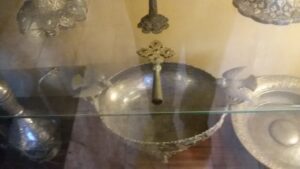BAPTISMAL FONT – Womb of the Church

Baptismal font (Gurno d Mamodito) is important feature, symbol and a sacred object in each Orthodox Church. It is a basin, vessel (gurno) or a receptacle made of stone or marble fixed on a pillar or pedestal with 3 and 1/2 feet high or a at a convenient height. It may be engraved with pictures of angels, cross, dove etc. It is used to baptise infants and is kept in the Bethgazo room or baptistery or in the Chancel (Azhiaagam) or in the Nave. The Sacrament of baptism served as their initiation into the Church, hence baptismal fonts are often placed at or near the entrance to the nave of the Church, south-eastern portion of the hyklo, to remind believers of their baptism as they enter the church to pray, since baptism is the entrance to our faith. The earliest baptismal fonts were designed for full immersion and were often cross shaped with steps (usually three, for the Trinity) leading down into them.
The baptismal font in the language of the Church Fathers is the Divine Womb whence we receive the second birth as child of God. Baptism is truly a birth. It represents the womb of our Church, wherein the spiritual birth of the faithful takes place, where the consequence of original sin is removed and the catechumen is united to the person to ‘The Body of Christ’ (Holy Church), and to open the door of salvation and eternal life to him or her.
The baptismal font also symbolizes the tomb of our Lord. Baptism is both death and new birth and it serves as a tomb and womb at once, as the same moment, one dies and is born, death of the old man, in solidarity with Adam and birth of a new man, united in Christ. Its water destroys one’s old life, drowning the old man and begets new life in Christ. When not in use, the Baptismal Font should be covered, with cover of cloth, wood or other material and nothing should be placed over it.

It also signifies the Sea/basin of the Jerusalem temple, where the priest washed so also the things for sacrifice were washed before sacrifice (2 Cor. 4: 10). In the Apostolic Age, as in Jewish times (John 3:2 3), baptism was administered without special fonts, at the seaside or in streams or pools of water (Acts 8: 38). Indoor baptism, however, was not uncommon (Acts 9:18) and, for the sake of both privacy and solemnity, came to be the rule; while reverence for the rite itself and for the water, which came in time to receive a special consecration, gave rise to the use of a special basin or font for the baptismal ceremony.

0 Comments